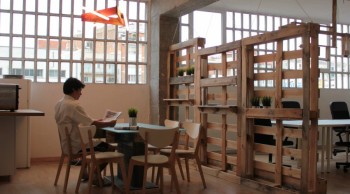What to do when your neighborhood industries produce masses of discarded wooden pallets? That was the question weighing heavily on the minds of the people who were tasked with building out, BCNewt, a new Barcelona-based co-working space. The challenge was to create a “communion between architecture, design and creativity” according to BCNewt designers.
The pallets of crates came courtesy of the industrial businesses in the area, only too glad to find a convenient means of disposal. The integration of the rough-hewn nature of 17 wooden timber structures into a modern, multi-dimensional, vibrant co-working space material, however, was another matter.
According to Mercurio Sobocki, interior decorator and project adviser, the crates themselves were a challenge, carrying an abundance of rusty nails that needed to be removed by hand. The crate timbers were gradually transformed into workable materials for the interior construction. One of the centerpieces of the space is a large central conference table, made entirely from the wooden crate materials. The table still bears the etched imprint of the European Railway Systems; a daily reminder to those sitting around it, as to the benefits of using re-purposed materials. The thinner strips of wood were used to create baseboards throughout the space.
BCNewt is just one of hundreds of co-working and business center operators who are riding the popular wave of using re-purposed materials in their spaces. It’s a trend tied very closely to the emerging millennial working population and it’s not showing any signs of retreating.
BCNewt project manager, Gustavo Franco, puts it into perspective. “The decor of coworking spaces is the wave of the future in terms of office decoration, as it appears to be more professionals each year seeking to establish their business in this type of activity space,” he remarked
Clearly this industry is moving away from traditional energy-sapping, non-organic centers and towards centers designed for sustainability and created from recyclable materials. This trend is particularly popular with co-working space owners and operators, but it carries a clear message to business center operators as well. Tomorrow’s occupants, in case you haven’t noticed, are already here. And the materials used to build out a space, along with the presence of sustainability features are geared to become a key element of features and amenities lists.


 Dr. Gleb Tsipursky – The Office Whisperer
Dr. Gleb Tsipursky – The Office Whisperer Nirit Cohen – WorkFutures
Nirit Cohen – WorkFutures Angela Howard – Culture Expert
Angela Howard – Culture Expert Drew Jones – Design & Innovation
Drew Jones – Design & Innovation Jonathan Price – CRE & Flex Expert
Jonathan Price – CRE & Flex Expert











